Today’s blog will cover top 5 blunders made from top elite chess grandmasters. This blog will be your solace and inspiration to never give up as such mistake are made from immortal legends themselves. The list is given below and are not ranked in any order but instead what caught my eye first and what I found while browsing through the internet.
Because mistakes and blunders are sometimes bound to happen in chess games and I’ll have lots of content to cover, I am starting this new series. The blunders are not rated in any order, they are just arranged according to what I found interesting. I have reserved other top blunders for next articles (like Grischuk missing mate in 1 against Anand), so stay tuned for that and read all my upcoming articles in this series. Note: The photos given below aren’t true to the date when the player blundered the chess match. Just disappointed faces of the elite grandmasters.
Anand losing in 6 moves
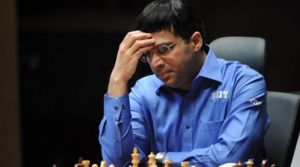
This game was played in round 9 of the Biel-B tournament. The opening is quite interesting and you’ll see why. For context, they played the Nimzowitsch Attack variation to the Russian game. In it’s true form, you can say they played the Petrov’s defense.
What?! How is this possible?? How did the former World Champion lose in 6 moves. I will tell you a deep secret behind this that most people don’t know. They only know the game but have no information and context about the game. Stay with me.
Anand was blindly following the analysis of an issue of informant. Yes, Anand was under the spell of the journal “Informator” and the Miles-Chrstiansen 1987 came contained within. I learned of this in “Steve Giddins’s 101 Chess Opening Traps” where he explains why all the aforementioned (except Zapata) “missed” 6. Qe2. Informator failed to explain that the Miles-Christiansen game had been agreed to be drawn before either had made a move. Although deviating from topic, what follows is priceless : “At the board, Tony saw that 6. Qe2 was winning, but remained the gentleman and avoided playing it. Mind you, I understand that he did spend some seconds ‘polishing’ the e2-square with his forefinger, until he was satisfied that Larry Christiansen’s face had assumed a suitable shade of red…”. LOL!
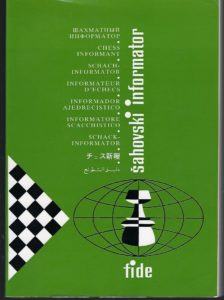
Anand was a GM at this time and had a rating of 2555. Zapata had been gifted his GM title 4 years prior this match and had a rating of 2480. Poor Anand. Because that move appeared in a magazine like an innovation. A match that continue with 6.Ce4? And Anand apparently didn’t analyze this variant so long. You can’t trust in those magazines.
For those of you thinking that 6..Qe7 is a good move that frees the knight to move but that just leads to worse scenarios. A very diabolical trap. It looks so playable, but as each response is continued Black loses ground in every way. Try to analyze that line on your own.
For those interested in the Miles-Christiansen game, I have attached it below. But there is no use analyzing as I once again repeat, it was a game prearranged to be a draw.
Magnus Keeps his extra pawn and offers his opponent a chance to checkmate

This game was the World Blitz Championship hosted in September 7th, 2006. This is round 7 and we see the Bastrikov variation against the Sicilian Defense. This game should be viewed from move 63 and on move 65 Carlsen plays 65. e5 and allows Merab Gagunashvili to checkmate him.
First of all, before I provide my perspective, I would like to mention two things. I am a pawn compared to Magnus and he will be one of the greatest chess players history has ever seen. He has played amazing chess games (at 13 years old he beat Kasparov! What else do I say)
Second of all, this was a blitz match. I couldn’t find a video or credible source, so I cannot say how much time both the players had on the clock. But all I can derive from simple logic and reasoning is that Blitz = MORE PRESSURE unless you are Alexander grischuk.

At the time, aside his own merits and talent, he received the best sponsorship and training of all time, trained and developed his enormous potential very early, i.e., he was(is) a prodigy himself with a great staff and good conditions. But he reached his peak prematurely.
I assure you he won’t make much progress from now on and slowly chess players from china and India would be able to overtake him. Others, who didn’t have the same opportunities, have much to improve yet. In a matter of time, some other young talents will appear with great performances too, starting out with Nihal Sarin, Rameshbabu praggnanandhaa and Alireza Firouzja who has already beat the World Champion. His performance at his age is unique, but I doubt magnus carlsen can’t avoid some king of stagnation.

I bet the difficultly he had against Gashimov will be the same in the next few years. In a perhaps grotesque comparison, I know, it’s only to exemplify: Bronstein or Andrei Sokolov, they showed all their potential very soon and after their peaks, they never reached the top again. If history and analytics speaks out, who are we to fight based on our intuition. A natural talented GM would never blunder this ridiculous way as Carlsen did because checkmate is the goal of the game and every move you look out for threats of checkmate whether it is blitz, rapid etc.
This might spark some debate in the chess community, but I would not like to glue my mouth and seal my opinions. I am more than welcome for constructive criticism and having debates with highly intellectual people. Racial slurs and rude behaviour will not be tolerated. It’s my perspective, your choice to take it or not.
Anatoly Karpov allows a fork to be played Larry Mark Christiansen

This game was played in January 18, 1993. The tournament is named Hoogovens Knockout and it is just round 2 of the tournament. We see the Petrosian variation to the Queen’s Indian Defense.
First off, I notice this game was played in 1993. 1992-1993 was kind of a slump for Karpov, losing three consecutive games at Tilburg (I think it was Tilburg) and losing the candidates match to the heavy underdog Short. At the time it seemed that Karpov, in his early 40s, was simply declining, but once he won the FIDE title in 1993 he came storming back, as formidable as ever.

Secondly, Karpov seems to have gotten certain opening lines mixed up here. This is why one should not become dependent on opening theory. At the top level, though, this is hard to do hence the vishwanathan Anand loss became all the news back in the day.
Also sometimes I get so accustomed to my opponents no longer attempting this sort of elementary tactic against me that I stop looking for the small stuff. I imagine this is what happened here to Karpov. My guess is that Karpov missed Christiansen’s last move because he never expected the Queen to return to its starting square after it has moved to c2. It looks unnatural because players are taught to develop their pieces as quickly as possible to prepare for the middlegame. But as Larry Christiansen demonstrated, there is always an exception to every rule.
A daring stunt performed by Christiansen when he added insult to injury by asking the former World champ, “Do you want to go over the game?” Ouch!! This was a big ego blow to Karpov and we would have seen any other grandmaster throwing tantrums and being angry. But no, Karpov demonstrated this in his following games.
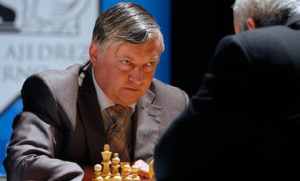
After this blunder, Karpov went on to defeat Christiansen in this match. 11…Qb8 was the ticket to establish a grip on the f4-square. Interestingly, Karpov in fact did play 11…Qb8 in the same position in another game after this debacle, and won. What’s even more funny is that Kasparov beat Christiansen 6-1 in this match. Amusing how this 1 game becomes iconic!
I guess the takeaway would be to play knight to h5 if you possibly have some concrete plan and strategy in mind. Nh5 is a move that Karpov wouldn’t normally make. The knight goes to the rim, and black’s bishop retreats a square. Unless …Bd6 justifies it, the whole idea is terrible. And, of course, this game highlighted the problem with Bd6.
Kramnik prefers trading queens over mate in 1
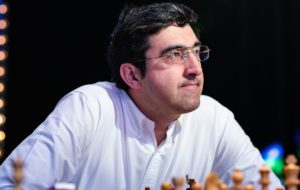
Firstly, I apologize to Kramnik because the title makes him seem like a complete fool which he is NOT.
This is the Kramnik vs Deep Fritz match played in November 27th, 2006. This is round 2 of that tournament and we see the Greco variation of the queen’s gambit accepted. If you directly want to see the position, you can start from move 34.
I think Kramnik must have been preoccupied with the queen trade and pushing the a pawn, and calculating how white would push the e pawn. That ending may be good for him. Instead, he got a different kind of ending.
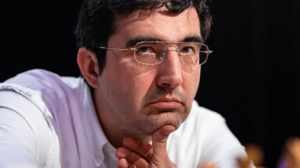
And now a quick digression from the topic because I have seen many people commenting all over the web regarding “the flaw in the algorithm”. Accepted that it is 2006 and deep friitz was not at all as strong as today but I don’t like that expression. That’s not technically correct. After a bit of computer science research and digging, I found out the algorithm is fine, it’s the good-old “minimax” technique. The computer is doing exactly what it was told to do, perfectly, and what the programmer told it to do is pretty much the only effective method we know of to come up with chess moves.
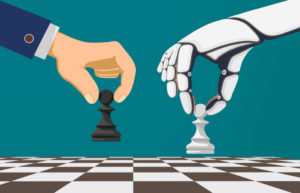
The problem for computers is that minimax techniques, with limited resources, sometimes misevaluates positions due to several factors. I can think of three off the top of my head:
(1) the horizon effect
(2) misappraisals of various positions, e.g. underestimating the value of king safety, or the value of a passed pawn in the ending
(3) inability to understand the significance of light/dark square complexes.
Nevertheless, it’s incredible how powerful these non-planning minimax brute-force number crunching machines can be. Apparently if you can calculate tactics well enough, you don’t need a plan. The computer’s plan is always the same: improve the position and snatch material whenever possible. Keep doing that and you win the game. But of course, now there are neural networks and better computer processing allowing computers to be virtually undefeatable.
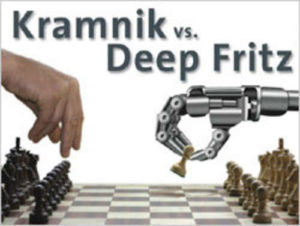
The final results of the tournament was that Deep Fritz won with 2 wins and 4 draws. Kramnik could have brought the game to a tiebreaker but the keyword is ‘could have’.

Anatoly Karpov offers his queen for a pawn
This game was played between Anatoly Karpov and Matthew Sadler. They played this in round 9 of the Melody Amber Blind 7th Tournament on March 22, 1998. We see the Queen Pawn Defense to the Zukertort Opening.
Before you become so shocked and dumbfounded as to how such a great player who Fischer was scared of blundered this position. It is a blindfold game at the Amerber tournament in Monaco. Although, in 1998 Karpov was still a very strong blindfold player. There is always at least a piece hung by someone in that tournament every year. But then there are some fairly deep combinations played too – especially by Kramnik.
He got confused because he intended to play the Queen’s gambit Accepted, prior to the game. So, he found a way to transpose back to his preferred opening.
But all in all, this smells a bit fishy though, because not only did the blunder happen so early, but he blundered the queen only 3 moves after he moved it onto the square that it was captured on so it should have still been ‘fresh’ in his brain. But that’s just my skepticism which is most likely false. It’s a blindfold game and as said before, the possibility of mistakes will be higher.

But that’s all for today. As shown in this article, I have covered mistakes between humans and computers, blindfold chess, regular chess everything. A blunder is a blunder and I will be covering all types of chess blunders with the only condition that they are played with the same rules and in a 8 * 8 board.
But that said, I hope you enjoyed this article. The reason for covering this topic is simple. To get the concept in your mind that everyone is human. Even top-tier grandmasters make mistakes so it’s alright to make one in your own game. I want you to accept every failure that comes in your way and instead of pulling your hair to death because of a stupid move, enjoy the beauty of the game while it lasts.
Happy Learning,
Yash Mehta


0 Comments